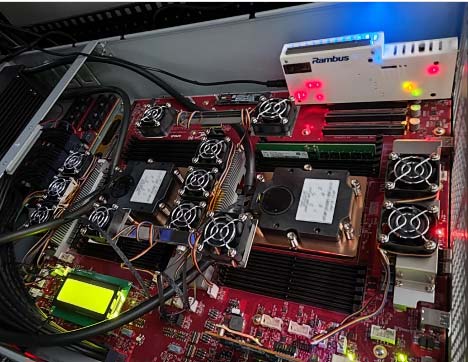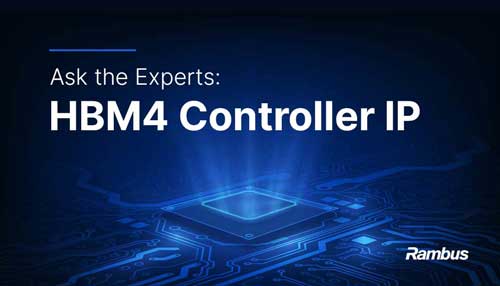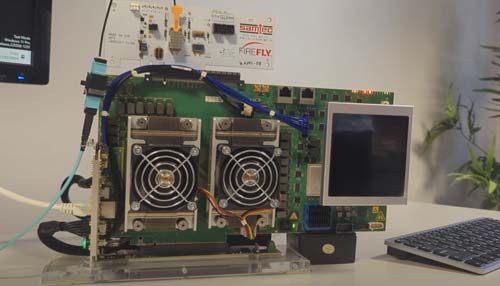Home > Interface IP > PCI Express Controller IP
PCI Express Controller IP
Rambus silicon-proven, high-performance PCI Express® (PCIe®) 7.0, 6.1, 5.0, 4.0 and earlier generation digital controllers are optimized for use in SoCs, ASICs and FPGAs. These market-leading solutions for high-performance interfaces address AI/ML, data center and edge applications.
| Version | Maximum Data Rate (GT/s) | Controller | Controller with AXI |
|---|---|---|---|
| PCIe 7.0 | 128 | ||
| PCIe 6.1 | 64 | ||
| PCIe 5.0 | 32 | ||
| PCIe 4.0 | 16 | ||
| PCIe 3.1 | 8 | ||
| PCIe 2.1 | 5 |
PCIe Controller IP
| Feature | PCIe 7.0 Controller | PCIe 6.1 Controller | PCIe 5.0 Controller | PCIe 4.0 Controller | PCIe 3.1 Controller | PCIe 2.1 Controller |
|---|---|---|---|---|---|---|
| Data Rate (GT/s) | 128 | 64 | 32 | 16 | 8 | 5 |
| Data Path | Scalable | Scalable | Scalable | Scalable | Scalable | Scalable |
| Topologies Supported | Root Port Endpoint Switch Port Dual-Mode | Root Port Endpoint Switch Port Dual-Mode | Root Port Endpoint Switch Port Dual-Mode | Root Port Endpoint Switch Port Dual-Mode | Root Port Endpoint Switch Port Dual-Mode | Root Port Endpoint Switch Port Dual-Mode |
| Duplex Lane Configurations | x1, x2, x4, x8, x16 | x1, x2, x4, x8, x16 | x1, x2, x4, x8, x16 | x1, x2, x4, x8, x16 | x1, x2, x4, x8, x16 | x1, x2, x4, x8, x16 |
| Backward Compatibility | 6.0, 5.0, 4.0, 3.1/3.0 | 5.0, 4.0, 3.1/3.0 | 4.0, 3.1/3.0 | 3.1/3.0 | 3.0/2.1/2.0 | 1.1/1.0 |
| Clock Gating/Power Gating | Yes | Yes | ||||
| Advanced RAS | Yes | Yes | Yes | Yes | Yes | Yes |
| Virtual Channel Support | FLIT and non-FLIT mode | FLIT and non-FLIT mode | ||||
| Forward Error Correction (FEC) | Yes | Yes | ||||
| L0p Low Power Mode | Yes | Yes | ||||
| Optional Features | IDE Security, AER, ECRC, ECC, MSI, MSI-X, Multifunction, Crosslink | IDE Security, AER, ECRC, ECC, MSI, MSI-X, Multifunction, Crosslink | AER, ECRC, ECC, MSI, MSI-X, Multifunction, Crosslink | AER, ECRC, ECC, MSI, MSI-X, Multifunction, Crosslink | AER, ECRC, ECC, MSI, MSI-X, Multifunction, Crosslink | AER, ECRC, ECC, MSI, MSI-X, Multifunction, Crosslink P2P |
PCIe Switch, Retimer, DMA and USB4 IP
| Solution | Product Brief | Description |
|---|---|---|
| PCIe 7.0 Retimer Controller | PCIe 7.0 Retimer Controller with CXL Support Provides Highly Optimized, Low-latency Data Path for Signal Regeneration | |
| PCIe 7.0 Switch | PCIe 7.0 Switch is a customizable, multiport embedded switch for PCIe designed for ASIC and FPGA implementations | |
| PCIe 6.0 Retimer Controller | PCIe 6.0 Retimer Controller with CXL Support Provides Highly Optimized, Low-latency Data Path for Signal Regeneration | |
| PCIe 6.2 Switch | PCIe 6.2 Switch is Customizable, Multiport Embedded Switch | |
| PCIe 5.0 Multi-port Switch | Customizable Multi-port Switch, Connects One Upstream Port to Up to 31 Downstream Ports | |
| PCIe Controller for USB4 | PCIe 5 Controller with USB4 Support, with Native Logic Interface Options | |
| PCIe Controller for USB4 with AXI | PCIe 5 Controller with USB4 Support, with AXI Logic Interface Options | |
| PCIe Switch for USB4 | Customizable Switch with USB4 Support, Connects One Upstream Port to Up to 31 Downstream Ports |
PCIe Debug and Test Solutions, and Add-On Cores
| Solution | Product Brief | Description |
|---|---|---|
| INSPECTOR for PCIe 5.0 | Interposer Card for Diagnostic Testing, Exercising and Debug of PCIe Devices at up to 32 GT/s | |
| Gen5HOST | Host Enabling Reference Platform for Prototyping and Development of PCIe 5.0 Devices and Apps | |
| Gen5ENDPOINT | Endpoint Reference Platform for Prototyping and Development of PCIe 5.0 Devices | |
| XpressAGENT | Add-on Core Simplifies Observability and Expedites Debugging of PCIe and CXL subsystems |
PCIe 7.0 Interconnect Subsystem
The Rambus PCIe 7.0 Controller exposes a highly efficient transmit (Tx) and receive (Rx) interface with configurable bus widths. Designed to satisfy a multitude of customer and industry use cases, the IP can be configured to support endpoint, root port, switch port, and dual-mode topologies, allowing for a variety of use models. The provided Graphical User Interface (GUI) Wizard allows designers to tailor the IP to their exact requirements, by enabling, disabling, and adjusting a vast array of parameters.

Rambus provides integration and validation of the PCIe 7.0 digital controller with the customer’s choice of 3rd-party PCIe 7.0 PHY.
Data Center Evolution: The Leap to 64 GT/s Signaling with PCI Express 6.1

The PCI Express® (PCIe®) interface is the critical backbone that moves data at high bandwidth and low latency between various compute nodes such as CPUs, GPUs, FPGAs, and workload-specific accelerators. With the rapid rise in bandwidth demands of advanced workloads such as AI/ML training, PCIe 6.1 jumps signaling to 64 GT/s with some of the biggest changes yet in the standard.
- Verilog RTL (source code)
- Libraries for functional simulation
- Configuration assistant GUI (Wizard)
- Reference designs
- Complete documentation
- Expert technical support
- Maintenance updates
- Customization
- SoC Integration



